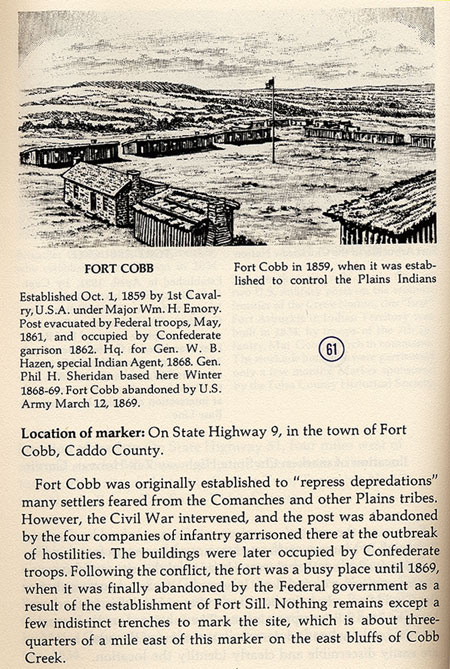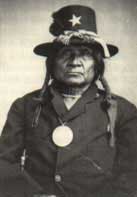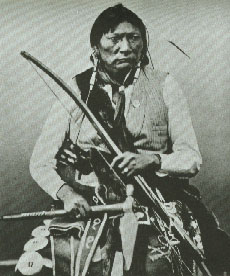
The above information is from the book, Mark of Heritage, by Muriel H. Wright,
courtesy of Oklahoma Historical Society.
On August 1 the work of removing the Indians from Texas began. As
upon other occasions when a people have been deported from their native
land, it was a sad affair. There was so much haste to get the Indians
away before the Texans attacked them that the Indians were unable
to round up their cattle. Mr. Neighbors was in charge, and he was
assisted by Agents Blain, S.P. Ross, and Mathew Leeper. A military
escort of two companies of cavalry and one company of infantry under
Major George H. Thomas, the future "Rock of Chickamauga," accompanied the long column. Horace P. Jones, Phillip McCusker, and
several other civilians came along as interpreters, employees of the
agency, and the like.
The above story is from the book, Carbine & Lance, The Story of
Old Fort Sill, by Colonel W.S. Nye; Copyright © 1937 by the University
of Oklahoma Press. Reprinted by permission. All rights reserved.
The United States began considering a location in Indian territory
for the tribes on the Texas reservation. In 1859, the commander of Fort
Arbuckle, Major Emory, found what he considered to be a good location
at Medicine Bluff in the Wichita mountains. Elias Rector, the senior
superintendent for Indian affairs, had final approval so Major Emory
provided him with an escort of fifteen soldiers under the command of
Lieutenant David Stanley. Rector, accompanied by Samuel A. Blain, agent
of the Wichitas, and Horace P. Jones, guide, and several Caddo and Wichita
chiefs left Fort Arbuckle, June 18, 1859. The four day trip was apparently
unpleasant for Superintendent Rector, as he openly detested the site
of his destination.
Maj. Robert H. Neighbors was forced to turn over his wards to the Indian
agent in Oklahoma. That night he wrote his wife in Texas.
I have this day crossed all the Indians out of the heathen land of
Texas and am now out of the land of the Philistines.
If you want a full description of our Exodus… read the "Bible"
where the children of Israel crossed the Red Sea. We have had about
the same show, only our enemies did not follow us…
The following indented story is from the book, Carbine & Lance,
The Story of Old Fort Sill, by Colonel W.S. Nye.
Mr. Blain's appointment left Leeper and Ross without jobs. They went
back to Texas with Neighbors. On his return to Belknap Neighbors was
murdered by Ed Cornett, a stranger to him, who resented his partisanship
to the Indians in the troubles between the redskins and the settlers.
…The military post of Fort Cobb was established October 1, 1859,
by two companies of the First Cavalry (formerly the First Dragoons)
and one company of the First Infantry, under Major W.H. Emory. It
was built of pickets and adobe, on the high ground east of the present
townsite. Camp Radziminski then was abandoned by the army, but immediately
was reoccupied by a regiment of Texas Rangers. The latter remained
at Radziminski for a year, patrolling the border and skirmishing with
the wild Indians. In the late summer of 1860 they marched north, accompanied
by some Tonkawas, Caddoes, and Wichitas. They attacked a camp of Kiowas
and Comanches near the head of the Canadian, in the country now known
as the Panhandle of Oklahoma.

Penateka Comanche Chief Silver Brooch
(Tosawi or Toshaway)
War brought turmoil to Indians living in Kansas and the Indian Territory,
with unfortunate results for Texans on the frontier. Most Cherokees,
Choctaws, Creeks and Seminoles aided the South, while others adhered
to the North. Few Comanches made a treaty with the South; but a great
majority with their allies, the Kiowas, held aloof from either side
and plundered the frontier at will. Apaches and Kickapoos did the same
from Mexico. Texas and Confederate troops, despite poor arms and mounts,
held defensive outpost until war's end.
The Union troops from Forts Cobb, Washita and Arbuckle retreated north
into Kansas when the Civil War broke out. Confederate soldiers garrisoned
Fort Cobb. Mathew Leeper was agent, he retained the assistance of Horace
Jones and J.J. Sturms. The Civil War broke out among the reservation
Indians. The civilized tribes, Cherokee, Choctaw, Chickasaw and Seminole
were large slaveholders and so seceded from the Union. The Creeks, Shawnee,
Delawares and some Cherokees sided with the Union. The Wasp Comanches
only wanted to continue raiding Texas so Chiefs Silver Broach and Milky
Way made no trouble on the reservation. Buffalo Hump, the third major
Wasp chief, sensed weakness and demanded Leeper have the government
build him a house. He caused such a ruckus around the agency that the
Caddoes and Tonkawas also became surly and threatened to join the Union.

Milky Way
Photo from the book, Carbine & Lance,
The Story of Old Fort Sill,
by Colonel Nye.
Confederate Brigadier General Albert Pike arrived in Fort Cobb in 1861
to make "A Treaty with the Comanches of the Prairies and Staked
Plains." The Confederate government provided sixty thousand dollars
in goods to the Comanches and Kiowas, who had been at war with the Union
"Bluecoats" for over two years. The gifts prevented Indian
raids into Texas for several years. September, 1862, Leeper heard rumors
that Union Indians were on their way to kill Tonkawas and Confederate
officials and took his family to a safe place, leaving Horace Jones
in charge.
Again we give you a story from the book, Carbine & Lance, The
Story of Old Fort Sill, by Colonel W.S. Nye.
At this time the Tonkawas were living along the Washita, south of
the agency. Hearing the uproar they abandoned most of their belongings
and fled east. Before daylight they halted and camped in a valley
southeast of the site of Anadarko, near the site of the present Catholic
mission. They thought they were safe. But the other Indians had trailed
them there, and had surrounded the camp. A merciless attack was made.
The Tonkawas were almost exterminated. Among those slain was the chief
of the band, Placido. The few who escaped found refuge at Fort Arbuckle,
then later went to Fort Griffin, Texas. The bones of their people
lay bleaching for many years in what is now called Tonkawa Valley.
The Confederates never reoccupied Fort Cobb. The semi-tame Indians
who had been attached to the agency were left to shift for themselves.
The following story is from the book, Comanches, The Destruction of
a People, by T.R. Fehrenbach.
There was a series of massacres and retaliations between the reservation
or agency Indians. The Tonkawa remnants that had been removed to Oklahoma
by Neighbors were almost exterminated, ostensibly because of their
"cannibalism," but more likely because the tribe's services
as scouts for the Texans had made them hated by the other Amerindians.
Federal agents also filtered back into the Indian Territory by 1862.
Some tribes changed sides: the Cherokees defected and rejoined the
Union. And in October 1862, "Union" Delawares and Shawnees
raided and destroyed the Confederate Wichita agency. The Pehnahterkuh
Comanches were dispersed into the Wichita mountains, and the link
between the Plains bands and the Confederates was broken.
|